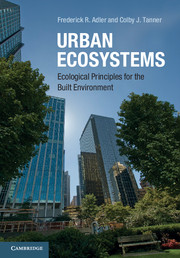4 - The ecology of urban organisms
Published online by Cambridge University Press: 05 May 2013
Summary
The biological and physical properties of urban areas shape the number, type, and behavior of people who live or work there. Factors such as water, open space, and pollution determine who can and will live in particular locations. The spatial pattern of urbanization controls such behaviors as the fraction of trips made on foot or by car. These choices then feed back to reshape the ecosystem itself.
All organisms share this reciprocal relationship with the environment, simultaneously shaping it and being shaped by it. The fundamental ecosystem cycles that affect climate, water, and nutrients arise from an interplay between human forces and organismal uses. This chapter studies how urban habitat modification, inputs and outputs, and ecosystem processes control the identities, abundances, traits, interactions, and evolution of urban plants, animals, and microbes.
From a broad community ecology perspective, urban regions, with their diverse habitat types and large resource inputs, can have surprisingly high levels of biodiversity for some groups of organisms (Section 4.1). In part, urban biodiversity results from the many non-native species that arrive and thrive in urban areas (Section 4.2).
- Type
- Chapter
- Information
- Urban EcosystemsEcological Principles for the Built Environment, pp. 139 - 252Publisher: Cambridge University PressPrint publication year: 2013

